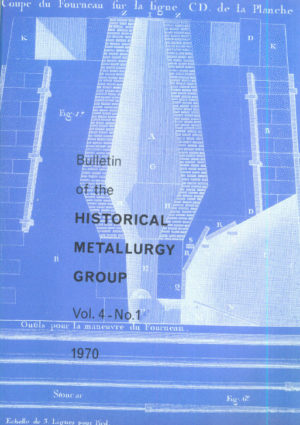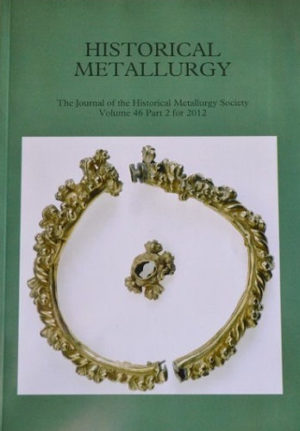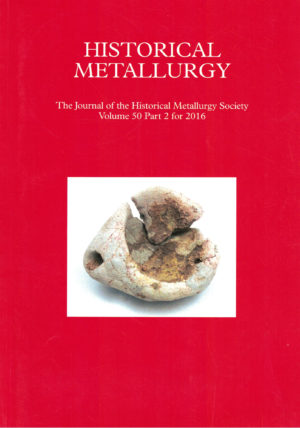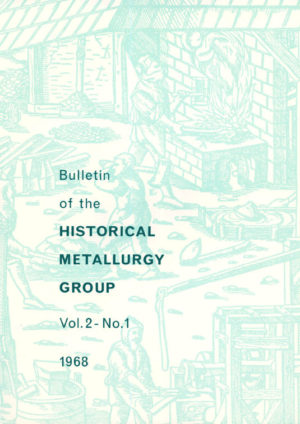Journal Contents
The iron clamps and dowels from the Parthenon and Ereehthion
G J Varoufakis
Pages 1-18
Twenty double T-cIamps taken from the Parthenon and the Erechthion in Athens were subjected to metallurgical analysis. The examination involved the longitudinal sectioning of three clamps and two dowels in order to allow better access to their true macrostructure. Previous studies were limited to a surface investigation of such items thus leading to incorrect conclusions regarding the number and the quality of the metal strips used to produce them. The present in-depth analysis suggests several important revisions.
In addition, the paper puts forward suggestions as to how these items were actually produced, based on attempts to simulate their production under conditions similar to those of antiquity. Chemical analysis showed that the ancients used exceedingly pure iron thus raising questions about the source of such raw materials and the location of smelting sites. The paper concludes with an attempt to illuminate the remarkable capacity of ancient clamps and dowels to withstand corrosion through the ages.
The metallurgist as entrepreneur: The career of Sir Robert Hadfield
Geoffrey Tweedale
Pages 19-30
Sir Robert Hadfield is now largely forgotten as a major industrial figure. True, in his native Sheffield some individuals would still recognise the company name “Hadfields” (if only for the controversial events surrounding the 1980 steel strike), but even they would probably be unable to identify its most illustrious member or recall any details about his life. The relics of Hadfield’s life in the city are rapidly being effaced: the firm’s famous East Hecla Works has been obhterated by Meadowhall shopping mall (without even a commemorative plaque); the Vestry Hall in Attercliffe, his birthplace, is now derelict; and so too is his country residence, Parkhead House. Hadfield’s life seems nothing more than a mordant comment on vanity and the ephemeral fame of “great men”, particularly industrialists.
Bronze metalworking at the Nuragic site of Santa Barbara, Sardinia, Italy
C Atzeni, L Massidda, U Sanna and P Virdis
Pages 31-35
Based on the results of physico-chemical and metallographic studies on material excavated at Santa Barbara-Bauladu (Sardinia, Italy) between 1986 and 1988, it may reasonably be assumed that the site was a foundry producing copper alloy artefacts during the early Iron Age (9th-8th centuries BC).
The major evidence is: copper and bronze nodules that may well be scraps and drippings from metalworking, ceramic fragments showing cupric encrustations altered through contact with materials at temperatures above 1100°C and presumed to be crucible remains and presumed to be crucible remains, and ceramic fragments thought to be remains of moulds for casting implements or weapons.
Some unsuccessful blast furnaces of the coke era
Philip Riden
Pages 36-44
Between about 1750 and 1790 iron smelting in Britain was transformed by the adoption of coke as fuel in the blast furnace instead of charcoal, and by the introduction of steam blowing in place of waterpowered bellows. In the middle of the century only three blast furnaces, all owned by the Darby family in east Shropshire, used coke, with almost the entire output of the industry coming from 60 or 70 charcoal fired furnaces. By 1790, the number of charcoal furnaces had dropped to about two dozen, mostly to be found in South Wales, the Forest of Dean and Fumess, whereas there were now some 70 coke-fired furnaces, concentrated on the coalfields of South Wales and the Midlands.
Studies of the alloy composition of more than two thousand years of Chinese coins (5th century BC-20th Century AD
Dai Zhiqiang and Zhou Weirong
Pages 45-55
This paper describes the development of Chinese coinage alloys from the 5th century BC to the 20th century AD. The authors studied the evolution of their composition, based on chemical analyses of more than 1,000 ancient Chinese copper-base coins, and found much important information including the exact time when China began to use brass for the minting of coins.
Silicon iron—the acid resisting alloy
Ralph V. Riley
Pages 108-111
Acid resisting silicon iron is essentially a casting alloy of iron containing 14%-16% silicon plus small quantities of other elements such as carbon, manganese, phosphorus, sulphur and nickel. Its discovery is credited to Jouve, a French metallurgist, in 1908. Its properties and method of manufacture were also studied by Dr. Rossi, Italy; and in 1910 castings were manufactured by Lennox Ltd. in London. When in 1912, silicon iron was manufactured in America under the trade name Duriron, pig iron containing 15% sihcon was shipped from London for remelting by the Duriron Company.
Since 1912 the metal has been used extensively in the acid industry in positions where resistance to strongly corrosive liquors coupled with metaUic properties were essential. I n the manufacture of acids, dephlegmator columns and evaporating pots are required to stand sulphuric acid in all concentrations at temperatures from atmospheric to 250°C. 15% silicon iron is highly suitable for such work and was widely used as, for example, in the manufacture of T N T for explosives. Some typical castings made for the ordnance factories are shown in the figures.
Iron ore for Newent Furnace
David Bick
Pages 61-62
In the study of iron-smelting before the large-scale production of the 19th century, it is tempting to assume that the ores came from well known sources quoted in standard works on iron deposits. There is however, considerable evidence that some charcoal furnaces, not to mention bloomeries, obtained supplies from small local outcrops that have been long since forgotten. Bog iron ores were exploited, and rarely have left any tangible evidence behind them.
The source of ore for the Newent Furnace, Gloucestershire, c. 1639-1751 (also known as Elmbridge or Oxenhall Furnace) and for long owned by the Foley family, was presumed to be hematite from the carboniferous limestone in the Forest of Dean, 6 or 7 miles to the south. However, it is conspicuously absent from a list of prices for Forest ore delivered to named furnaces as ordered by the Court of Mine Law on 27th April 1680, at which period it was certainly in blast. The enigma was eventuaUy resolved by the Foley Partnership Accounts, where many references to ‘myne (ore) from Mr Foley’s land at Aston’ may be found.
Some misunderstandings concerning the use of blacksmiths tongs
David Sim
Pages 63-65
The use of tongs by the blacksmith is discussed. The importance of correct interpretation of usage of specific tools in relation to the forging of iron is examined.
In memoriam Cyril Stanley Smith 1903-1992
Page 66-
![[Test] The Historical Metallurgy Society](https://test.historicalmetallurgy.org/wp-content/uploads/2020/02/Logo120.png)





There are no reviews yet.